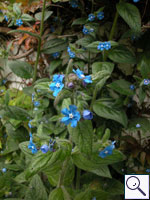|
||||||
|
PENTAGLOTTIS. Green Alkanet. [Boraginaceae] |
|
|
Only one species of Pentaglottis, Green Alkanet (P. sempervirens), is recorded in Britain. It is introduced. Three British miners are recorded mining Pentaglottis. A key to the European miners recorded on Pentaglottis is provided in Bladmineerders van Europa. |
 Green Alkanet Pentaglottis sempervirens |
Key for the identification of the known mines of British |
|
1 > Leaf-miner and case-bearer: The larva feeds in a distinctive case made from hairy leaf fragments of the foodplant. The young larva feeds on the developing seeds and hibernates in its first case which is made of the tip of a petal. After hibernation it makes a hoary, laterally flattened composite leaf case (resembling a willow catkin). Full depth mines are made at the margin of the leaves, that thereby look peculiarly damaged. Mouth angle 70°. Initially forms a blotch mine, in the centre of a leaf, which it excises for its initial case. In the spring it repeatedly extends its case and it resembles a jagged catkin of willow. The larva may wander from its foodplant and attach to other plants or fences etc. |
|
|
|
Coleophora pennella (Denis & Schiffermüller, 1775) [Lepidoptera: Coleophoridae]. |
|
| 1b > Leaf-miner: A
large, irregular blotch mine with a short linear section in the
first instar which is frequently entirely enveloped in the fully
developed mine and may then be no longer visible (Spencer,
1976: 124).
Perhaps the only character differentiating it from abiens is the presence of several larvae in a fully developed mine of abiens and just one in myosotidis. Puparium reddish brown |
|
|
|
Agromyza myosotidis Kaltenbach, 1864 [Diptera: Agromyzidae]. |
|
| 1c > Leaf-miner: A
narrow linear leaf-mine, which developes into a large blotch. Several
larvae frequently feed together and the resulting mine can entirely
fill the leaf (Spencer, 1976:
89).
The mine begins with a narrow, parallel sided corridor af 1-8 cm in length, with a nice double frass line. After the first moult the corridor is succeeded, and mostly overrun, by a large, primary, brown blotch. Frass in the initial corridor in short thread fragments, in the blotch in angular granules and thread fragments that often are branching (the frass is unusally sticky). Primary and secondary feeding lines conspicuous. The final mine often is very large and generally contains several larvae, because normally several mines develop on a leaf, and coalesce into one big blotch. Before pupation the larvae leave the mine through a semicircular exit slit that mostly, but not invariably, is in the upper epidermis. The initial narrow gallery contains frass in a double line. It then expands to form a blotch mine. Several larvae may occupy a leaf to form a large blotch. |
|
|
|
Agromyza abiens Zetterstedt, 1848 [Diptera: Agromyzidae]. |
|
| Last updated 06-Jul-2019 Brian Pitkin | ||
